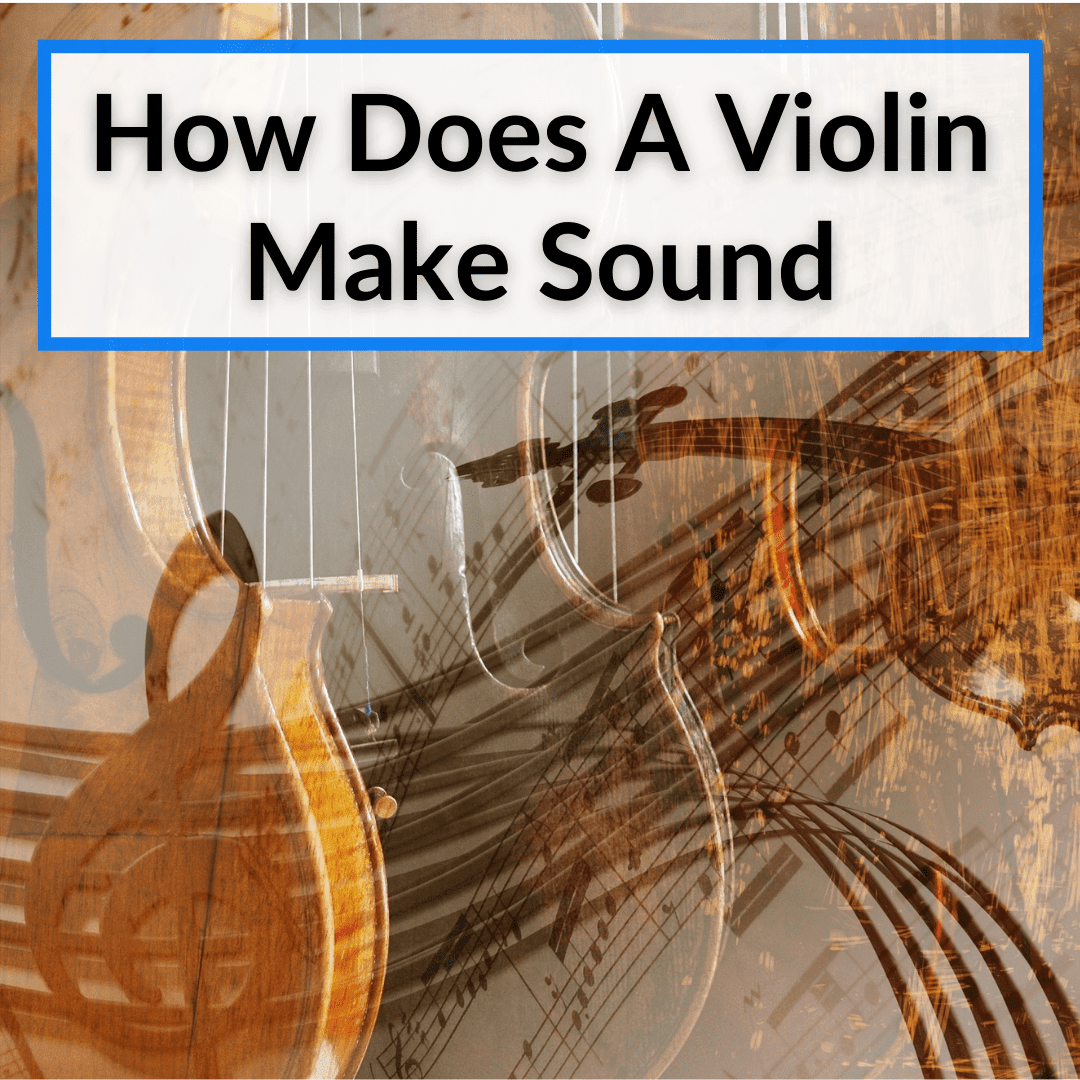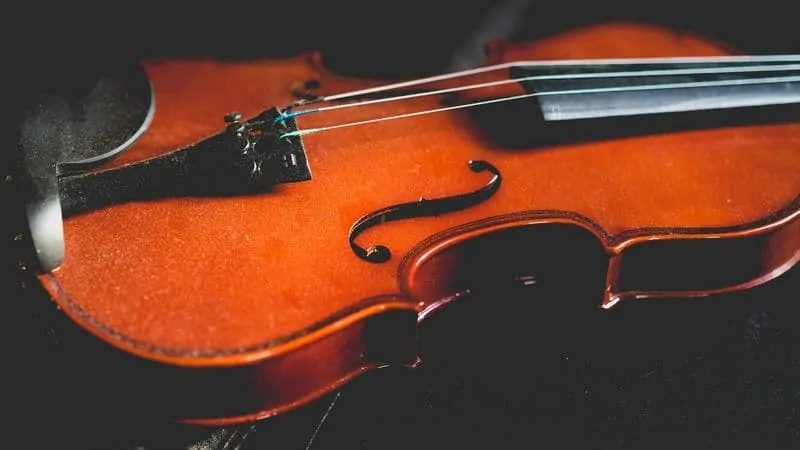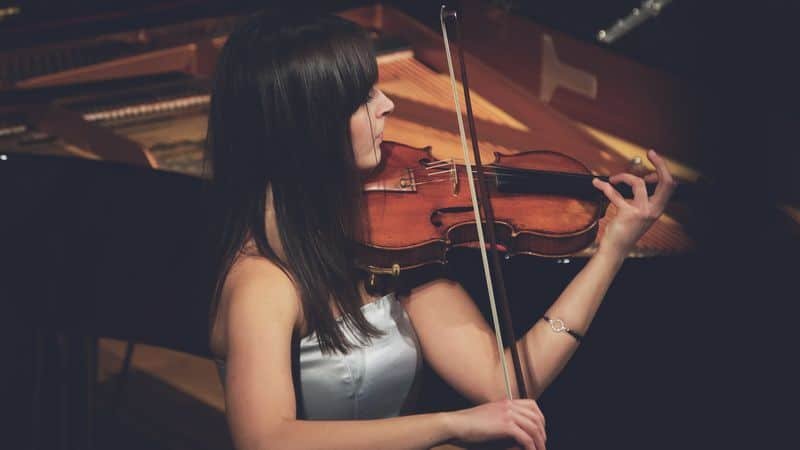 Violins produce a beautiful sound.
Violins produce a beautiful sound.
Assuming you know how to play them.
If not, they still produce a sound. It’s not beautiful though.
But how do they produce sound at all, whether beautiful or not?
All you’re doing is rubbing one fiber against another.
How does that result in such a clear and precise tone?
Keep reading to learn exactly how a violin makes sound. It’s a pretty amazing little invention, once you understand how it works.
Table of Contents
How Does A Violin Make Sound?
In short, the sound of the violin can be produced in two ways: by pulling a horsehair bow over one of the four strings, or by pulling the strings with your fingers.
Of course, playing the violin is much more than that. There is a reason it’s commonly considered one of the most difficult instruments to play.
So let’s get into more detail. We’ll examine both the physical manifestation of the sound and how to achieve it with proper technique.
Structure Of A Violin
The violin is an instrument of great complexity from an acoustic point of view. As has happened for almost all instruments, the experience of the builders and performers has empirically perfected the characteristics over time.
The acoustic chain of the violin is made up of the following elements:
Top, Back, Ribs
These are the three wooden parts that make up the hollow body of the instrument. Two “f”-shaped openings are carved on the body.
Both the top and the bottom are not flat, but slightly rounded. They are not of constant thickness, but taper from the center to the periphery.
Soundpost, Bass Bar
These are two elements inside the body of the instrument. The soundpost is a small wooden cylinder, similar to a column, between the top and the bottom.
The bass bar is a curved strip glued longitudinally under the body. These two elements have the structural function of distributing the loads from the tension of the strings, and the acoustic function of coupling the oscillations of the top and the back.
Scroll, Tailpiece, Bridge, Strings
The first two elements are the fixed points between which the strings are stretched. The scroll is located at the end of the neck on the fingerboard. It is where the tuning pegs are.
The tailpiece is near the performer’s chin. The bridge determines the actual acoustic length of the strings and transmits the vibration. We have a separate article that covers what the strings on a violin are made of, tuned to, and more.
The strings are the part that will need to be replaced regularly. Different violin strings last different lengths of time, but all will need to be replaced every few months to one year.
How Sound Is Produced
The sound comes out by rubbing the violin strings with horsehair stretched over a wooden bow. This causes the strings to vibrate. But they vibrate very weakly in the air.
The sound of a string without the amplification is very weak. For this reason, the body of the instrument has a critical function in determining the timbre.
The vibration that occurs in the strings is transmitted in part to the bridge, and from this to the soundboard.
The top, in turn, is mechanically coupled to the back, employing the soundpost and the bass bar. And the vibrations of the whole body of the instrument are then transmitted to the surrounding air.
The whole body of the instrument, therefore, performs the dual function of the resonance chamber and impedance adapter.
As a resonance box, it “filters” the oscillation of the strings, approximately triangular in origin, through its own frequencies, and transforms it into an oscillation with a more complex shape.
As an impedance adapter, the body of the violin ensures that the mechanical energy present in the oscillation of the strings is effectively transformed into acoustic energy, which propagates in the air and therefore allows the sound to be radiated over great distances.
This means an audience can hear it, but in many cases it does still need to be amplified. That means you need to use a microphone to capture the violin.
Performing Technique
In the technique of playing the violin, unlike most other instruments, the role of the left and right hand is completely different.
While the right hand directly performs the tone, pulling the bow over the strings, the left determines the pitch. The fingers, pressing the string against the grip, reduce its sounding length.
The frog holds the bow and is normally pulled down invariably. At the lower end of the bow, the pressure on the wire is more direct, and even naturally stronger.
Starting from that end produces more direct and dynamically accentuated tones. Moving the bow down creates a natural decree for unstressed tones and a quieter sound, and moving from the top to the frog gives a natural crescendo.
There are numerous ways in which bows are played on strings and this makes the string articulation the richest and most refined of all instruments.
You can play the violin by holding it in various ways. Most players hold the lower part of the instrument between their left shoulder and jaw, often aided by a semi-permanently attached chin rest and detachable shoulder rest.
If you hold it properly under the chin, you can release the instrument from your hands and it will stay there firmly. There are also other unconventional ways of holding the violin.
Chin and shoulder rest accessories come in a wide range of styles and shapes, so everyone should be able to find the combination that best suits their build and style of play.
The search for the ideal combination can be time-consuming in some cases. Regardless of the equipment, the player will usually strive to maintain a balanced, natural, and comfortable posture, with upright spine, especially the neck.
Many violinists have a reddish mark on their neck, the so-called “violin hickey”, from prolonged pressure on the site. The point may be exacerbated by an allergic reaction to nickel plating on the chin strap fitting or to microbiological pathogens present on the instrument.
Keeping the left wrist relaxed and almost “straight” allows freedom of finger movement and reduces the possibility of recurrent injuries.
Breaking the wrist to “support” the violin with the left hand is an unfortunate habit that many beginners fall into, and it may take years of constant vigilance to overcome it.
The left forearm will be rather extremely supinated, and the left elbow pulled medially or to the right. Players may sometimes be advised to bring their left elbow where they can see it, to make it easier to reach the lower wires.
It is easy to raise a shoulder outside the natural relaxed position without noticing it. Like any other unjustified tension, this restricts freedom of movement and increases the risk of discomfort, while reducing sound quality.
It may sound trivial, but the correct posture is incredibly important for getting the right sound out of the violin (or, often, any sound at all).
How A Violin Makes Sound: Final Thoughts
A good violin is a finely crafted instrument in which every part plays a role in producing the beautiful final sound. Hopefully this article has given you a clearer idea how everything works and how your simple action of pulling the bow cross the strings results in the final sound.




Leave a Reply